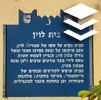The sign shape is rectangular but its head is designed according to the silhouette of the old building of the Gymnasia Herzliya, which serves as a logo of the Council for the Preservation of Heritage Sites in Israel
The building was photographed that day
 Click for a larger image
Click for a larger image  Click for a larger image Translation of the text on the sign
Click for a larger image Translation of the text on the sign:
Symbol of the Council for the Preservation of Israeli Heritage Sites
Symbol of the Ministry of Culture and Sports
The emblem of the Binyamina colony
Zar’onia Khan Zarunya was established in the late 19th century by the Ottomans, as a private manor house of a Bosnian Effendi named Sadek Pasha. The khan is called "Zaronia" after the grain in the area, or "Zarkania" after Wadi Zarka - the crocodile stream, which flows from the north.
At the beginning of the twentieth century, YCA acquired the site.
In 1920, two working groups settled in Khan: the "California group" - young people from Israel who went to California to study agriculture, and the "Dutch group" - young people from Eastern Europe who immigrated to the Netherlands and during the First World War united and prepared to settle in Israel. The groups stayed there for a few years and then settled in the new colony of Binyamina.
During the Mandate, Zaroniya Farm was an experimental station for growing jasmine for the perfume, vines and various fruit trees industry. An eucalyptus tree nursery was also established on the farm to produce Caesarea sands. In the mid-1920s, Dr. Gustav Reich (Elyakim Nagid), an agronomist who worked at PIKA, was appointed director of the experimental farm in Zaronia. He lived there with his family until the farm closed.
Until the 1960s the place was deserted and destroyed, then the place passed into private hands, and today it is used as a private residence.
The preservation of the site was initiated by Shula and Zeev Mozes.
Conservation Architect: Eyal Ziv, a. Architects

 Click for a larger image
Click for a larger image  Click for a larger image
Click for a larger image  Click for all signs belonging to Heritage Sites in Israel
Click for all signs belonging to Heritage Sites in Israel
 1.54 Km |
1.54 Km |  1.58 Km |
1.58 Km |  2.01 Km |
2.01 Km |  6.42 Km |
6.42 Km |  7.17 Km
7.17 Km